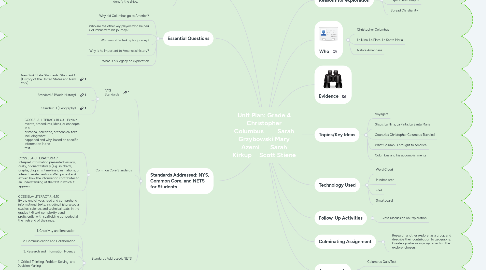
1. Reasons for exploration
1.1. Faster route to Asia and the Indies
1.2. Expand their empire
1.3. Spread Christianity
2. Who
2.1. Christopher Columbus
2.2. La Nina, La Pinta, La Santa Maria
2.3. Native Americans
3. Evidence
4. Topics/Key Ideas
4.1. Voyagers
4.2. Ships: La Nina, La Pinta, La Santa Maria
4.3. Countries Christopher Columbus Traveled
4.4. What Columbus brought to America
4.5. Columbus and his accomplishments
5. Homework
5.1. Crossword Puzzle with key terms
5.2. Mystery color number map that ends up showing the 3 ships and have students identify the ships.
6. Essential Questions
6.1. Why did Columbus go to America?
6.2. Who are the other key players who helped Columbus with his journey?
6.3. Who was affected by his journey?
6.4. Why is he important to America's history?
6.5. What is his legacy on exploration
7. Technology Used
7.1. Word Cloud
7.2. Mindmeister
7.3. iPad
7.4. Smartboard
8. Follow-Up Activities
8.1. Class Discussion on Exploration
9. Culminating Assignment
9.1. Research another explorer as a group and describe their contribution to geography. Create a poster as a group reflecting the explorer chosen.
10. Assessments
10.1. Columbus Quiz/Test
10.2. Create a Flipgrid where a student talks about what they think Columbus' greatest achievement was
11. Standards Addressed: NYS, Common Core, and NETS for Students
11.1. NYS Standards
11.1.1. New York State Standards: Standard 1 (History of the United States and New York)
11.1.2. Standard 2 (World History)
11.1.3. Standard 3 (Geography)
11.2. Common Core Standards
11.2.1. CCSS.ELA-LITERACY.RI.4.3 Explain events, procedures, ideas, or concepts in a historical, scientific, or technical text, including what happened and why, based on specific information in the text.
11.2.2. CCSS.ELA-LITERACY.RI.4.7 Interpret information presented visually, orally, or quantitatively (e.g., in charts, graphs, diagrams, time lines, animations, or interactive elements on Web pages) and explain how the information contributes to an understanding of the text in which it appears.
11.2.3. CCSS.ELA-LITERACY.RI.4.10 By the end of year, read and comprehend informational texts, including history/social studies, science, and technical texts, in the grades 4-5 text complexity band proficiently, with scaffolding as needed at the high end of the range.
11.3. Standards Addressed: NETS
11.3.1. 1. Creativity and Innovation
11.3.2. 2. Communication and Collaboration
11.3.3. 3. Research and Information Fluency
11.3.4. 4. Critical Thinking, Problem Solving, and Decision Making
11.3.5. 5. Digital Citizenship
11.3.6. 6. Technology Operations and Concepts

